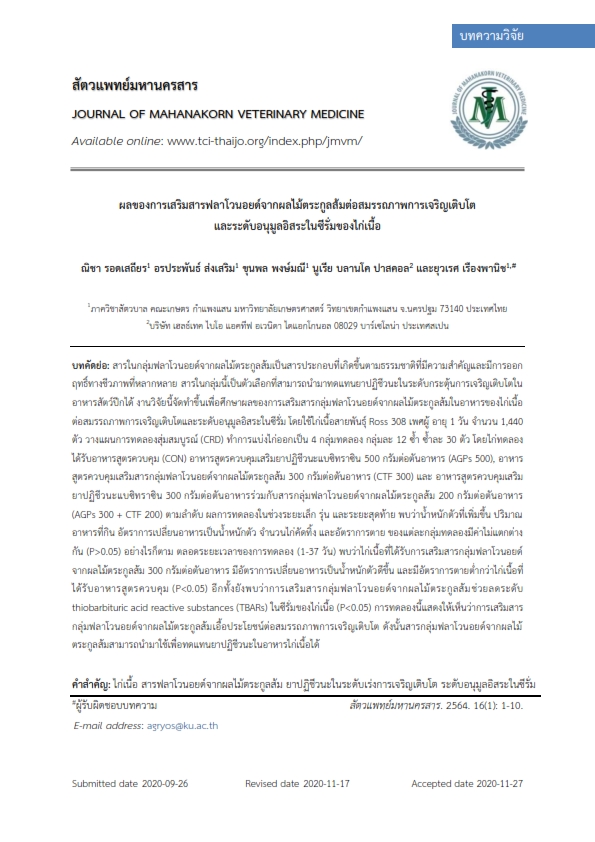Effect of Citrus Flavonoids Supplementation on Growth Performance and Serum Oxidant Levels of Broilers
Main Article Content
Abstract
Citrus flavonoids are important natural compounds with diverse biological activities. They can be used as an alternative to replace antibiotic growth promoters (AGPs) in poultry diets. This experiment was conducted to determine the effect of citrus flavonoids on growth performance and antioxidant status in broilers. A total of 1,440 one-day-old Ross 308 male broiler chicks were randomly allotted into 4 treatments with 12 replicates of 30 birds per replicate. The chicks were fed a control diet (CON), a control diet supplemented with 500 g of bacitracin/ton of feed (AGPs 500), 300 g of citrus flavonoids/ton of feed (CTF 300), or a mixture of 300 g of bacitracin/ton of feed and 200 g of citrus flavonoids/ton of feed (AGPs 300 + CTF 200), respectively. There were no significant differences in body weight gain, feed intake, feed conversion ratio, number of culling and mortality among dietary treatments during the starter, grower and finisher periods (P>0.05). However, for overall performance (1-37 DOA), birds fed diets supplemented with citrus flavonoids alone had lower FCR and mortality (P<0.05) when compared to that of the control group. In addition, the supplementation of citrus flavonoids alone reduced serum thiobarbituric acid reactive substances (TBARs) of broiler (P<0.05). The present study indicates that, citrus flavonoids had beneficial effects on growth performance. Therefore, citrus flavonoids could be used as a substitute for antibiotic growth promoters in broiler diets.
Article Details

This work is licensed under a Creative Commons Attribution-NonCommercial-NoDerivatives 4.0 International License.
References
Afolayan, M., F. Abeke, and A. Atanda. 2016. Ascites versus sudden death syndrome in Broiler Chickens: A Reveiw. J. Anim. Prod. Res. 28(2): 76-87.
Akbarian, A., A. Golian, A. Gilani, H. Kermanshahi, S. Zhaleh, A. Akhavan, S. De Smet, and J. Michiels. 2013. Effect of feeding citrus peel extracts on growth performance, serum components, and intestinal morphology of broilers exposed to high ambient temperature during the finisher phase. Livest. Sci. 157(2-3): 490-497.
Altan, Ö., A. Pabuçcuoğlu, A. Altan, S. Konyalioğlu, and H. Bayraktar. 2003. Effect of heat stress on oxidative stress, lipid peroxidation and some stress parameters in broilers. Brit. Poult. Sci. 44(4): 545-550.
Alzawqari, M., A. Al-Baddany, H. Al-Baadani, I. Alhidary, R. U. Khan, G. Aqil, and A. Abdurab. 2016. Effect of feeding dried sweet orange (Citrus sinensis) peel and lemon grass (Cymbopogon citratus) leaves on growth performance, carcass traits, serum metabolites and antioxidant status in broiler during the finisher phase. Environ. Sci. Pollut. Res. 23(17): 17077-17082.
Ansari, I. H., R. Mostafizer, I. Zohorul, C. D. Bhajan, H. Ahasan, and H. B. Shariful. 2014. Prevalence and antimicrobial resistance profile of Escherichia Coli and Salmonella Isolated from diarrheic calves. J. Anim. Health Prod. 2(1): 12-15.
Awad, W., K. Ghareeb, and J. Böhm. 2011. Evaluation of the chicory inulin efficacy on ameliorating the intestinal morphology and modulating the intestinal electrophysiological properties in broiler chickens. J. Anim. Physiol Ani. N. 95(1): 65-72.
Berrong, S., and K. Washburn. 1998. Effects of genetic variation on total plasma protein, body weight gains, and body temperature responses to heat stress. Poult. Sci. 77(3): 379-385.
Brennan, J., J. Skinner, D. A. Barnum, and J. Wilson. 2003. The efficacy of bacitracin methylene disalicylate when fed in combination with narasin in the management of necrotic enteritis in broiler chickens. Poult. Sci. 82(3): 360-363.
Cavia-Saiz, M., M. D. Busto, M. C. Pilar-Izquierdo, N. Ortega, M. Perez-Mateos, and P. Muñiz. 2010. Antioxidant properties, radical scavenging activity and biomolecule protection capacity of flavonoid naringenin and its glycoside naringin: a comparative study. J. Sci. Food Agric. 90(7): 1238-1244.
Church, D. F., and W. A. Pryor. 1985. Free-radical chemistry of cigarette smoke and its toxicological implications. Environ. Health Persp. 64: 111-126.
Cogliani, C., H. Goossens, and C. Greko. 2011. Restricting antimicrobial use in food animals: lessons from Europe. Microbe 6(6): 274-279.
Esterbauer, H., R. J. Schaur, and H. Zollner. 1991. Chemistry and biochemistry of 4-hydroxynonenal, malonaldehyde and related aldehydes. Free Radical Biol. Med. 11(1): 81-128.
Fellenberg, M., and H. Speisky. 2006. Antioxidants: their effects on broiler oxidative stress and its meat oxidative stability. World's Poul. Sci. J. 62(1): 53-70.
Gardiner, E., J. Hunt, R. Newberry, and J. Hall. 1988. Relationships between age, body weight, and season of the year and the incidence of sudden death syndrome in male broiler chickens. Poult. Sci. 67(9): 1243-1249.
Kamboh, A. A., and W. Y. Zhu. 2014. Individual and combined effects of genistein and hesperidin on immunity and intestinal morphometry in lipopolysacharide-challenged broiler chickens. Poult. Sci. 93(9): 2175-2183.
Marzoni, M., R. Chiarini, A. Castillo, I. Romboli, M. De Marco, and A. Schiavone. 2014. Effects of dietary natural antioxidant supplementation on broiler chicken and Muscovy duck meat quality. Anim. Sci. Pap. Rep. 32: 359-368.
Miyake, Y., K. Minato, S. Fukumoto, K. Yamamoto, T. Oya-Ito, S. Kawakishi, and T. Osawa. 2003. New potent antioxidative hydroxyflavanones produced with Aspergillus saitoi from flavanone glycoside in citrus fruit. Biosci. Biotech. Bioch. 67(7): 1443-1450.
Panche, A. N., A. D. Diwan, and S. R. Chandra. 2016. Flavonoids: An overview. J. Nutr. Sci. Vitaminol. 5: 1-15.
Sethiya, N., S. Thakore, and S. Mishra. 2009. Comparative evaluation of commercial sources of indigenous medicine shankhpushpi for anti-stress potential a preliminary study. Pharmacology Online 2: 460-467.
Siddiqui, M. F., M. S. Patil, K. M. Khan, and L. A. Khan. 2009. sudden death syndrome – An overview. Veterinary World. 2(11): 444-447.
Simitzis, P., G. Symeon, M. Charismiadou, A. Ayoutanti, and S. Deligeorgis. 2011. The effects of dietary hesperidin supplementation on broiler performance and chicken meat characteristics. Can. J. Anim. Sci. 91(2): 275-282.
Tollba, A., and R. Mahmoud. 2009. How to control the broiler pathogenic intestinal flora under normal or heat stress conditions. 1-Medical plant-probiotics-sand as a litter. Egypt. Poult. Sci. J. 29(2): 565-587.
Wanaporn, T. 2014. Alternatives to the use of antibiotics as growth promoters for livestock animals. J. Agr. 30(2): 201-212


